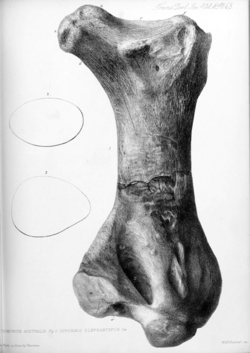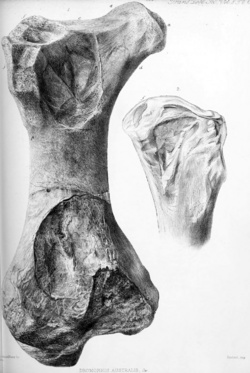Biology:Dromornis australis
| Dromornis australis | |
|---|---|

| |
| Photolithograph of holotype specimen | |
| Scientific classification | |
| Domain: | Eukaryota |
| Kingdom: | Animalia |
| Phylum: | Chordata |
| Class: | Aves |
| Order: | †Gastornithiformes |
| Family: | †Dromornithidae |
| Genus: | †Dromornis |
| Species: | †D. australis
|
| Binomial name | |
| †Dromornis australis Owen, 1872
| |
Dromornis australis is an extinct species of flightless birds found in Pliocene deposits of Australia . They were once considered the smallest species of the genus Dromornis, around three quarters the size of Dromornis stirtoni, until the discovery of Dromornis planei specimens were described in 2016.
Taxonomy
The species, first described by Richard Owen in 1872, is the type of the genus Dromornis and family Dromornithidae. Owen's new taxon was published in a series on prehistoric birds, read before the Zoological Society of London then appearing in its Transactions.[1][2] The fossil remains of a large femur were discovered at Peak Downs in Queensland, at a depth of around 180 feet in a well shaft. This type locality was described as an assemblage of boulders and pebbles beneath around thirty feet of alluvial soil, the femur was located over a boulder in the rock beds.[3] The description of Dromornis australis by Richard Owen, best known for extensive work on the paleontology of Australian mammals, was the first of an extinct Australian avian species.[4]
Owen had previously sought evidence of Dinornis in the palaeontological collections of early Australian excavations. A femur that he had noted in the appendix of Thomas Mitchell's explorations, found in a cave, did not allow him to confirm an alliance with any previously described species of large flightless birds.[2] Owen withheld describing that specimen, now thought lost, until the type for this species emerged many years later.[5] The new material had been found while digging a well at Peak Downs and forwarded to Owen via W. B. Clarke, a geologist employed by the state of New South Wales, with a remark by Gerard Krefft that placed it with the New Zealand moas of Dinornis. Richard Owen found affinities and distinctions in an osteological comparison to species of the extinct Dinornis and the extant Dromaius (the emu) and proposed that it represented a new genus.[2][6]
As the type for the genus, a revision that reassigned this single specimen would have taxonomic consequences.[6]
The placement of this dromornithid species may be summarised as
Dromornithidae (8 species in 4 genera)[7]
- Dromornis australis Owen, 1872
- Dromornis murrayi Worthy et al., 2016[8]
- Dromornis planei (Bullockornis planei Rich, 1979)
- Dromornis stirtoni Rich, 1979
The Dromornis lineage is proposed to represent a monotypic succession, from earliest to latest these are D. murrayi, D. planei, D. stirtoni, and this species, D. australis.[5]
Description

The species is known by the right femur, around twelve inches long, obtained at the Peak Downs site. The details of the its deposition accompanied Owen's description, "The well was sunk through 30 feet of the black trappean alluvial soil common in that part of Australia, and then through 150 feet of drift pebbles and boulders, on one of which boulders ("at that depth," 150 feet?) rested a short, thick femur, so filled with mineral matter (calc spar and iron pyrites) as to give the internal structure more the appearance of a reptilian than an ornithic bone."[2] Owen notes the specimen was reported by W. B. Clarke, attributing it to Dinornis, in the Geological Magazine several years before.[9]
The femur is similar in size to Ilbandornis woodburnei, another dromornithid species. Other osteological features of the specimens have been compared to Dromornis stirtoni, the gigantic "Stirton's thunderbird".[6]
A comparative analysis that included this femur indicated morphological characters assignable to either Dromornis or a continuation of a Ilbandornis woodburnei lineage, allied to more gracile species of the family, but these results were not considered to be necessarily characteristic to any dromornithid genera. A fragment of synsacrum found at the Canadian deep lead mine near Gulgong has been tentatively assigned to Dromornis, the slight possibility that it is referable to this species might represent the continuation of the lineage as a smaller species into the Pliocene.[6]
References
- ↑ Owen, R. (1872). "June 4, 1872". Proceedings of the Zoological Society of London 1872: 682–683. doi:10.1111/j.1469-7998.1872.tb00495.x. https://www.biodiversitylibrary.org/part/73729.
- ↑ 2.0 2.1 2.2 2.3 2.4 Owen, R. (1874). "On Dinornis (Part XIX.): Containing a Description of a Femur indicative of a new Genus of large Wingless Bird (Dromornis australis, Owen) from a post-tertiary deposit in Queensland, Australia". Transactions of the Zoological Society of London (Published for the Zoological Society of London by Academic Press) 8: 391–383; Pl. LXII, LXIII. https://biodiversitylibrary.org/page/28778786.
- ↑ Rich, Pat Vickers (1980). "The Australian Dromornithidae: a group of extinct large ratites". Contributions in Science 330: 93––103. https://www.biodiversitylibrary.org/part/226841.
- ↑ Lingham, Barry (2011). "Mihirungs: Giant Birds of the Dreamtime". Geelong Naturalist (The Club) 47: 8–9. https://www.biodiversitylibrary.org/page/60619103#page/10/mode/1up.
- ↑ 5.0 5.1 Handley, W. D.; A. Chinsamy; A. M. Yates; T. H. Worthy (2016), "Sexual dimorphism in the late Miocene mihirung Dromornis stirtoni (Aves: Dromornithidae) from the Alcoota Local Fauna of central Australia", Journal of Vertebrate Paleontology, doi:10.6084/M9.FIGSHARE.3422146.V1
- ↑ 6.0 6.1 6.2 6.3 Murray, Peter; Vickers-Rich, Patricia (2004) (in en). Magnificent mihirungs: the colossal flightless birds of the Australian dreamtime. Bloomington: Indiana University Press. pp. 50–51. ISBN 978-0-253-34282-9.
- ↑ Handley, Warren D.; Worthy, Trevor H. (15 March 2021). "Endocranial Anatomy of the Giant Extinct Australian Mihirung Birds (Aves, Dromornithidae)". Diversity 13 (3): 124. doi:10.3390/d13030124.
- ↑ Worthy, Trevor H.; Handley, Warren D.; Archer, Michael; Hand, Suzanne J. (3 May 2016). "The extinct flightless mihirungs (Aves, Dromornithidae): cranial anatomy, a new species, and assessment of Oligo-Miocene lineage diversity". Journal of Vertebrate Paleontology 36 (3): e1031345. doi:10.1080/02724634.2015.1031345.
- ↑ Clarke, W. B. (1869). "Dinornis, an Australian genus". The Geological Magazine, or, Monthly Journal of Geology. (Cambridge University Press.) 6 (62): 383–384. doi:10.1017/S0016756800162855. Bibcode: 1869GeoM....6..383C. https://www.biodiversitylibrary.org/page/32512880.
Wikidata ☰ Q909965 entry

